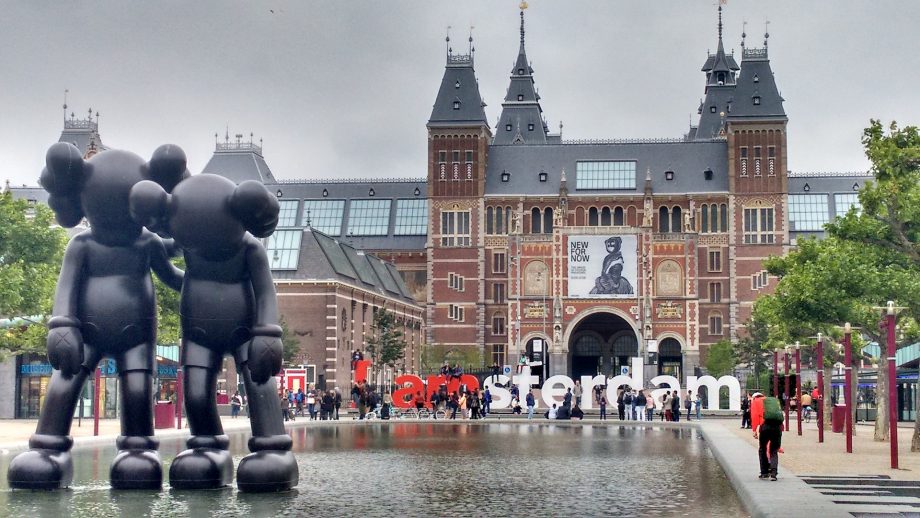Amsterdam History
Amsterdam is considered the greatest planned city of northern Europe. It has always been a well-known name in world history and it played a central role in the building of the Netherlands. From its humble beginnings as a 13th century fishing village on the River Amstel, to its current role as a major hub for business, tourism and culture, Amsterdam has had a strong tradition as a centre of culture and commerce. In the 17th century Amsterdam was the centre of world economy, and nowadays the city is known for its tolerant character.
Saying that, although The Netherlands remained neutral during the First World War due to food shortages there were riots in Amsterdam in 1917. In 1939 the Dutch remained neutral again, but Germany invaded anyway in 1940 and during the Second World War most of the Jews in Amsterdam were deported. (Anne Frank House opened to the public in 1960 – more about that below). After the war Amsterdam was able to flourish again.
Amsterdam is also able to lay claim to being the world’s oldest stock exchange, not London as they would have us believe! Established by the Dutch East India Company in 1602, this financial institution once occupied the impressive Beurs van Berlage building, which still stands today.
Getting Around Amsterdam
There are so many options for you to choose from for how to get around Amsterdam. Whether you’re visiting for the shops and markets, stunning music and nightlife or the city’s best restaurants, finding your way around Amsterdam is very easy. There are efficient, cheap and integrated trams, metros and buses, and in the centre most places can be reached on foot. The most popular method, and one for which Amsterdam is famed, is the bike, and this is how most locals tend to get around. You can also take boats and water taxis. Beware though, public transport provision for those with disabilities is notoriously dire.
If you choose to ride a bike there are bike lanes on most roads, marked by white lines and bike symbols. Sadly due to a prevalence of thieves you can never leave a bike unlocked. Take note too, most bikes have pedal-backwards brakes (as opposed to handlebar-mounted), which take some getting used to. There are plenty of places to rent bikes, for about €10 a day, note that a passport and/or credit card is required when hiring them.
As mentioned above, you can take boats and water taxis because Amsterdam is best seen from the water. There are canal cruises you can join in on or you can try to bond with a local boat owner; otherwise your options are limited to the pedal-powered canal bike or pedalo. Upon rental of any water vessel, pay attention to the rules of the water (at its most basic: stick to the right and be very wary of canal cruisers, who always assume that their size gives them an inherent right of way).
Eating out in Amsterdam
One thing Amsterdam is very famous for is its unique food. Below are a list of local delicacies that you are going to want to partake in when visiting this fabulous city:
- Bitterballen – delicious, deep fried crispy meatballs traditionally served with mustard for dipping. They’re the ultimate in Dutch pub snacks and can be found on the menu at most Amsterdam drinking establishments.
- Stroopwafel – If you try one Dutch sweet treat, make it a stroopwafel. Two thin waffles stuck together with a layer of sweet syrup; these delectable delicacies are best enjoyed hot and gooey from a street market or bakery.
- Thick Dutch fries – these are not just any fries. You might see these thick cut fries called patat or frites on menus, and traditionally they come served in a piping hot paper cone slathered with any manner of tasty toppings. Ask for ‘patatje oorlog’ for a dollop of peanut satay sauce, mayo and onions, or a ‘patat speciaal’ for a mix of curry ketchup, mayonnaise and onions.
- Raw herring – this may sound a little scary to the uninitiated, but every visitor to Amsterdam should give it a go. You’ll spot haringhandels (herring carts) serving up this Dutch speciality all over the city – ask for a ‘broodje haring’ to get the fish served in a small sandwich with pickles and onions. The best time to try raw herring is between May and July when the herring is said to be at its sweetest.
- Kibbling – if you’re not feeling quite brave enough to try raw herring, then you can still get your fishy fix from kibbeling – battered and deep fried morsels of white fish; usually cod. They’re every bit as delicious as they look, and usually served with a mayonaisey herb sauce and lemon. Try it hot and fresh from a street market or food truck for the best kibbeling experience.
- Oliebollen – the name literally means ‘oil balls’ – but don’t let that put you off. Essentially they are deep fried sweet dumplings (sometimes containing fruit pieces) and dusted in powdered sugar, and they’re so delicious that they only come out around New Year’s Eve, just before the January diet kicks in.
We can’t forget to mention cheese. Cheese is big business in the Netherlands, so don’t go home without visiting one of Amsterdam’s many ‘kaas’ shops or markets and tasting some Gouda, Geitenkaas or Maasdammer. For an introduction to the most popular Dutch cheeses, stop by the Cheese Museum or one of the Henri Willig Cheese and More shops.
What To Do In Amsterdam
Bike – As mentioned above biking is huge in Amsterdam. There are over 800,000 bicycles in Amsterdam. That’s more bikes than people! Cycling in Amsterdam is a way of life, made easier by the city’s unbeatable network of cycle routes and flat landscape.
Visit Jordaan – Often cited as Amsterdam’s most charming neighbourhood, wandering into the Jordaan feels like stepping back in time. Originally a working class area, the Jordaan’s narrow streets and quaint buildings now make up one of Amsterdam’s most desirable quarters, dotted with independent art galleries, antiques shops, courtyard gardens and atmospheric bars and restaurants.
Get cultured in Museumplein – Home to the Rijksmuseum, the Van Gogh Museum and the Stedelijk Museum of Modern Art, Museumplein is the cultural beating heart of Amsterdam. The open square between the buildings pulses with activity all day; with open-air exhibitions, markets and a large paddling pool to dip your toes into on warmer days. In the winter months, the square transforms with a vast outdoor ice rink.
Cruise on the canal – There are many different canal cruises to choose from: from hop-on-hop-off sightseeing tours to atmospheric candlelit night time cruises with food and wine. Created in the 17th century to keep the sea at bay, Amsterdam’s UNESCO protected canal belt is the quintessential picture-postcard vision of Amsterdam, and an unbelievably pretty sight by both day and night.
Visit Anne Frank’s House – Reflect on the atrocities committed against the Jewish people during World War II at the Prinsengracht house where diarist Anne Frank and her family hid from the Nazis for two years after feeling persecution in Germany. The front of the house is now a thought-provoking museum but the back annex has been preserved to give an idea of what life was like for Anne and the families she hid with.
Visit a market – Whether you’re looking to snag a bargain, try some local delicacies or just soak up the atmosphere, visiting one of the many markets in Amsterdam is a unique and unforgettable experience. Some of the most popular Amsterdam markets include the Albert Cuypmarket in De Pijp, Westerstraat market in the Jordaan (held on Monday mornings), the floating flower market on the Singel and the Waterlooplein flea market near the Rembrandt House.
See a Van Gogh – No trip to Amsterdam could be complete without paying homage to Dutch impressionist Vincent Van Gogh. The modern building on Museumplein is home to more than 1000 of the artist’s paintings, drawings and letters, and offers visitors the chance to not only get up close and personal with some of his instantly recognisable works, but also to track his development and learn more about the artists who inspired, and were inspired by, him.


